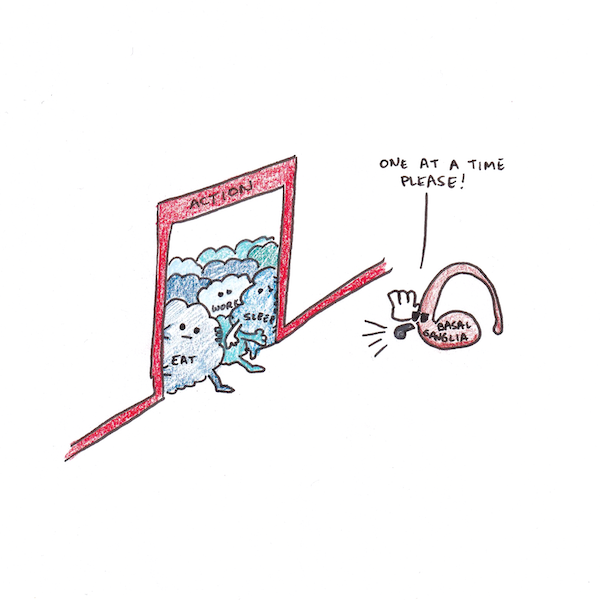The Neuroscience of Motivation
In the last essay, I shared why it was important to think about success in terms of systems, not inspiration. This isn’t because motivation isn’t important — rather it’s because motivation is itself a kind of system. If you can understand it, you can change it.
Success as systems may not be so dramatic, but the results speak for themselves. The steady accumulation of wealth, building of fitness and acquisition of skills aren’t going to lead to any Oscar-worthy moments, but the outcome is a better life. Provided, of course, you master the processes that lead to them.
Unfortunately, a major challenge in making progress is that our brains simply aren’t designed for a lot of the long-range goal-setting that’s necessary for success.
How Motivation Works Inside Your Brain
Inside your head, nestled deep behind your brain’s neocortex is a relatively ancient part of the brain known as the basal ganglia. This little blob of tissue receives inputs from many different cortical regions, including your frontal cortex (thinking, working memory) and motor cortex (physical actions).
The problem the basal ganglia solves is that our brains are massively parallel computing structures. Billions of neurons and trillions of synapses all firing independently. Yet, we need to take one and only one action at a time. Try to sit down while jogging and you’ll probably fall.


How the basal ganglia accomplishes this is with a pattern called the motor loop. Basically, it locks all actions by default. Only when an action gets enough support from dopamine-carrying neurons from the substantia nigra, does it go through. These dopaminergic neurons are trained to be reward-predictors — anticipating which set of actions will lead to the best rewards.
The circuitry guiding our thoughts and actions is exquisitely complicated. I’ve only provided a crude summary. But it does have a big limitation — our motivational impulses are remarkably short-term. As motivational researcher Piers Steel commented in our interview:
A week is actually, motivationally a long, long way off. A couple days, yeah, that’s pretty much it.
Motivation comes with an eye-dropper when you want it, and a firehose at the end. What we want is a nice tall glass of motivation, but we don’t really have that. We have this really messed up system.
In brief, while we have an excellent system for predicting rewards and choosing the best action to take, the system is remarkably short-sighted. Messed up indeed.
Imagine Water Flowing Downhill
Neuroscience is fascinating, but it doesn’t always give a visceral sense of the implications of this system. To that end, I’d like to propose a visual metaphor that doesn’t capture the full complexity of the computations going on, but gives a good gist.
Imagine your motivation as water sitting on a hill. The action you take is determine by where the water flows. It doesn’t take a physics doctorate to realize that the direction it flows is wherever the slope is the highest. Water flows downhill.
Now, however, imagine that where you want to go is downhill, except there’s a slight lip of land keeping the water flowing further. What happens in real life is obvious — you get a puddle at the top of your mountain. Even if the water “wants” to flow to the bottom, it can’t get over that little hump.

We can imagine our motivation similarly. We want to be rich, fit, smart and successful, but the action required in the short-term requires some effort — it is motivationally uphill. Compared to other, immediately-rewarding alternatives, our impulse will be to procrastinate. Why work hard today for an uncertain future, when I can get an immediate dopamine hit from watching Netflix?
One solution to this problem is simply to try to tilt the playing field. If your motivation is strong enough, temporarily, you might even be able to do it. I think of those puzzle games where you have to roll a ball bearing through a maze, but you can only do it by tilting the game as a whole.
As a short-term solution this works. But often the little humps of motivation required aren’t one-time, but continuous. Exercising isn’t a single cost, but a small amount of effort every time you go to the gym.
An alternative, then, is to smooth off the bumps. If you can reduce friction to your goal, the behavior you want to flow can be realized with a much smaller tilt.
Another strategy is to dam up the easier paths. Reducing the salience of opportunities when you need to make progress on your goals can make them easier. If the easy escape route is momentarily blocked, you’ll be more likely to flow downhill again.
Even better is to design a new path for your goal. If you can have it more consistently pointed downhill, the water might flow of its own accord, no smoothing or damming required. The person who gets in shape doing an activity they love (dancing, skiing, hiking) they might not need nearly as much motivation to get started.

Designing Better Goals
The analogy with water is an imperfect one. For one thing, water can only roll down in a few directions. The possible actions you can take in any moment is nearly infinite — thus attention and beliefs also form constraints in that they limit which actions are even being considered at any particular moment.
However, what I hope this idea illustrates is the skill of designing your motivational efforts. If you change the problem from, “how do I motivate myself enough to reach this goal” to, “how can I design the goal so that motivation is automatic” you’ll end up making far more progress.
P.S. — If you liked this article, you may like my course Make It Happen!

